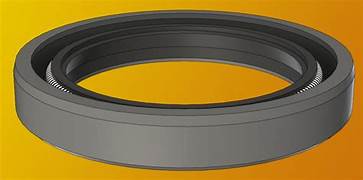Understanding the Basics of Shaft Lip Seals: A Complete Guide

Shaft lip seals are an essential component in many mechanical systems. They play a crucial role in preventing the leakage of fluids and contaminants and ensuring the smooth operation of the machinery.
Whether you are a mechanical engineer, a maintenance technician, or simply interested in understanding the workings of these seals, this complete guide will provide you with all the necessary information.
In this article, we will walk you through the basics of shaft lip seals, their types, functions, common applications, and factors to consider when selecting one. So, let’s dive in!
What are Shaft Lip Seals?
Shaft lip seals, also known as oil seals or rotary shaft seals, are mechanical devices designed to seal the gap between a rotating shaft and its housing.
They prevent the leakage of lubricants, such as oil or grease, and the ingress of contaminants, such as dirt, water, or dust, into the system. Shaft lip seals are typically made of elastomeric materials with a metal casing and a flexible sealing lip that makes contact with the shaft.
The lip is designed to provide a dynamic seal that accommodates the rotational movement of the shaft while maintaining the required sealing efficiency.
Types of Shaft Lip Seals
Shaft lip seals come in various types to suit different applications and operating conditions. The two main types of seals are:
- Radial lip seals: These seals are commonly used in rotary applications where the shaft rotates relative to the sealing surface. They consist of a flexible lip that makes contact with the shaft, creating a barrier to prevent the leakage of fluids or contaminants. Radial lip seals are typically used in automotive engines, industrial machinery, and hydraulic systems.
- Axial lip seals: Unlike radial lip seals, axial lip seals are used in applications where the shaft moves axially or reciprocates. These seals have a lip that faces the pressure side and helps to prevent the leakage of fluids or contaminants.
Axial lip seals are commonly used in hydraulic cylinders, reciprocating pumps, and other equipment with linear or reciprocating motion.
Both types of shaft lip seals are designed to provide effective sealing while withstanding the forces and operating conditions of the specific application.
They are typically made from materials such as rubber, elastomers, or thermoplastics to ensure compatibility with various fluids and operating temperatures.
Additionally, shaft lip seals may incorporate additional features like dust lips or exclusionary lips to provide further protection against contaminants.
Functions of Shaft Lip Seals
Shaft lip seals serve several important functions in mechanical systems. Some of their key functions include:
- Providing a barrier between two areas to prevent the escape of fluids or contaminants. This is particularly important in applications where a rotating shaft passes through a housing or casing, such as in pumps or gearboxes. The lip seal helps to ensure that the fluid or lubricant remains within the system and does not leak out.
- Reducing or preventing the ingress of contaminants or foreign particles into the system. The lip seal creates a tight seal around the rotating shaft, preventing dust, dirt, or other contaminants from entering the system. This helps to maintain the cleanliness and integrity of the internal components, prolonging their lifespan and performance.
- Lubrication retention. In applications where lubrication is essential for the smooth operation of the system, the lip seal helps to retain the lubricant in the desired area. It acts as a barrier that prevents the lubricant from leaking out and ensures that it is effectively distributed to the necessary components.
- Minimizing friction and wear. The design of shaft lip seals often incorporates features such as a sealing lip or special materials that reduce friction and wear between the seal and the rotating shaft. This helps to enhance the efficiency and longevity of the system by minimizing energy losses and component degradation.
- Acting as a static or dynamic seal. Shaft lip seals can be used as static seals, where the shaft does not rotate, or as dynamic seals, where the shaft rotates. The lip seal is designed to accommodate the rotational movement of the shaft while maintaining an effective seal.
Shaft lip seals play a crucial role in ensuring the proper functioning and reliability of mechanical systems by providing sealing, contamination prevention, lubrication retention, and minimizing friction and wear. Their selection and proper installation are essential for optimizing system performance and preventing costly downtime.
Common Applications of Shaft Lip Seals
Shaft lip seals are widely used in various industries and applications. Some of the common applications include:
Sutomotive industry, industrial machinery, power generation, chemical processing, and food processing. In the automotive industry, shaft lip seals are used in engines, transmissions, and differentials to prevent the leakage of oil and lubricants.
In industrial machinery, these seals are crucial for maintaining the proper function of rotating equipment such as pumps, compressors, and motors. In power generation, shaft lip seals are used in turbines and generators to prevent the escape of steam and other fluids.
In chemical processing, these seals play a vital role in preventing contamination and leakage of hazardous chemicals. Similarly, in food processing, they are used to ensure the hygiene and integrity of the products being processed.
Shaft lip seals are essential components that provide effective sealing and protection against leakage in a variety of industries and applications.
Factors to Consider When Selecting a Shaft Lip Seal
When selecting a shaft lip seal for a specific application, several factors need to be considered:
Operating Conditions: The first factor to consider is the operating conditions of the application. This includes the temperature, pressure, and speed at which the seal will be functioning. Different lip seals are designed to handle different ranges of operating conditions, so it is important to choose one that can withstand the specific requirements of the application.- Fluid Compatibility: The second factor to consider is the compatibility of the lip seal with the fluid that it will be exposed to. Different materials are resistant to different fluids, so it is important to choose a lip seal that will not degrade or fail when in contact with the specific fluid in the application.
- Shaft Surface: The third factor to consider is the condition of the shaft surface. The lip seal relies on a smooth shaft surface to create a tight seal, so any imperfections or damage to the shaft can affect the performance of the seal. It is important to carefully inspect and prepare the shaft surface to ensure proper sealing.
- Lubrication: The fourth factor to consider is the availability and type of lubrication in the application. Some lip seals require lubrication to function properly, while others are designed to operate without lubrication. It is important to choose a lip seal that is compatible with the lubrication used in the application or select a seal that does not require lubrication.
- Installation: The fifth factor to consider is the ease of installation of the lip seal. Some lip seals require special tools or techniques for installation, while others can be easily installed by hand. It is important to choose a lip seal that can be properly installed in the application without causing damage or compromising the seal.



